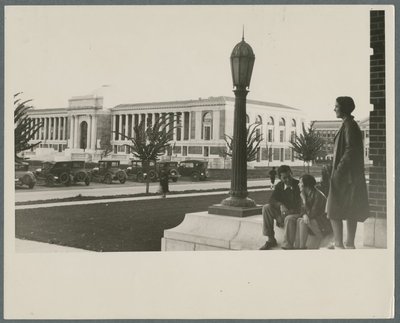The Oregon State University campus has always been beautiful. It has evolved to meet the changing needs of students and staff, with spaces for gathering and strong support for academics and research.
When we think about physical spaces, it is important to recognize that the ability to “inhabit” or “exist” in a space can be complicated. Excluding gender-segregated residence halls and recreational facilities, women were never formally restricted from any campus location. However, though academic spaces or courses of study weren’t explicitly segregated, women were often directed to “acceptable” places to congregate and learn.
Historically, several buildings served as women’s spaces. These include Snell Hall (women’s dormitory), Milam Hall (School of Home Economics building), co-op living facilities, and Home Management program houses.
No discussion of the physical environment for women can ignore the significance of Waldo Hall. Built as a women’s dorm in 1909, Waldo also provided living accommodations for female faculty. The building served as the Domestic Science program’s erstwhile lab space, and was used to teach cooking, home nursing, laundry, and etiquette. Declared unsafe for residence in the mid-1960s, Waldo was nearly demolished a decade later. Now protected as a part of the campus’ National Historic District distinction, the building was renovated and is home to multiple academic units.
Unsurprisingly, the Women’s Building is also crucial to the story of women’s experiences. Completed in 1926, it served as the home for women’s physical education and intramural recreation well into the 1970s. Even in the early years after Title IX passed, OSU’s gymnastics, volleyball, and women’s basketball teams practiced and competed in the Women’s Building rather than Gill Coliseum. And generations of co-eds learned to swim in its pool!
Though most people on campus know it as the Women’s Center, the small blue building just off the library quad has been home to chemistry, paleontology, and glass blowing programs since it was built in 1892. Women claimed the space for themselves – literally – in 1973. Led by Jeanne Dost, a group sought space for women and men to discuss feminist issues, listen to speakers, and study women’s literature. The Physical Plant manager suggested the old “Paleontology Building,” which was scheduled for demolition the following summer. Those crews never arrived and in the past forty-five years, the building has become a central place for students, staff, and faculty of all gender identities. By creating community, engaging in direct action, and providing services that even included counseling in its early years, the Women’s Center has shed light on uncomfortable realities, and catalyzed real progress on issues ranging from self-confidence to pay equity to sexual violence.

